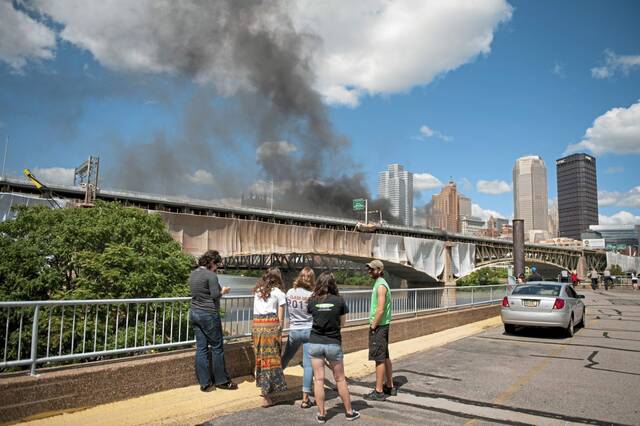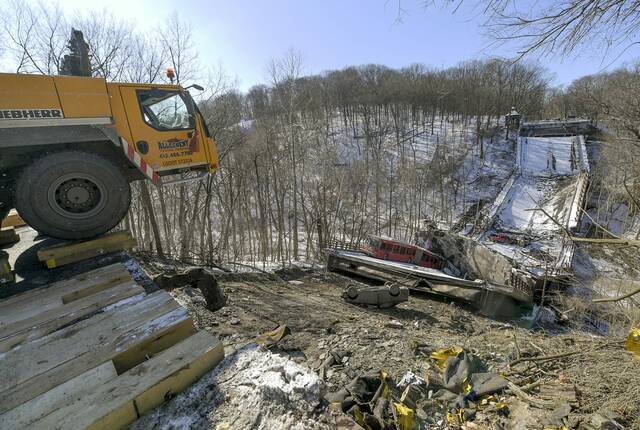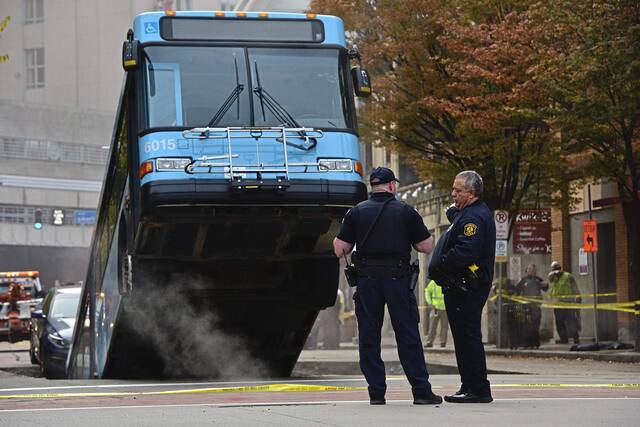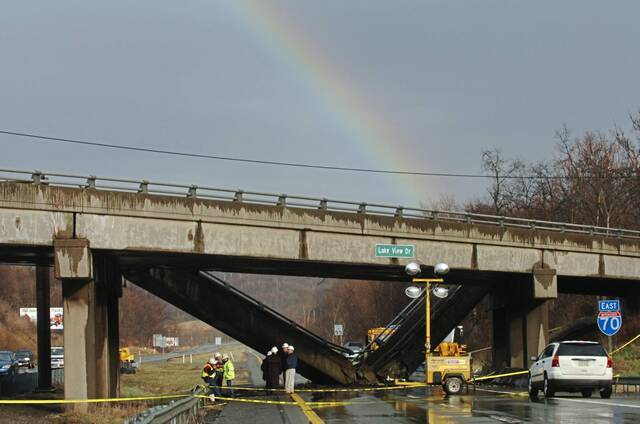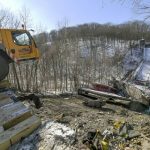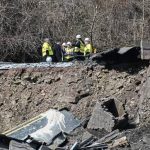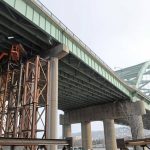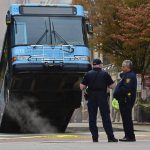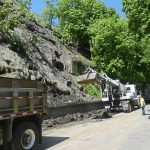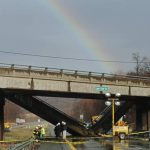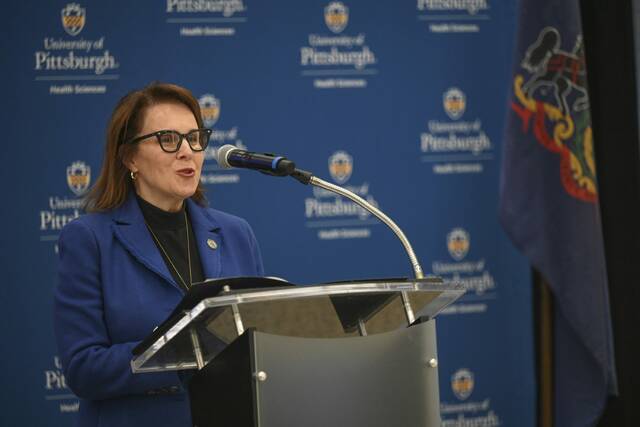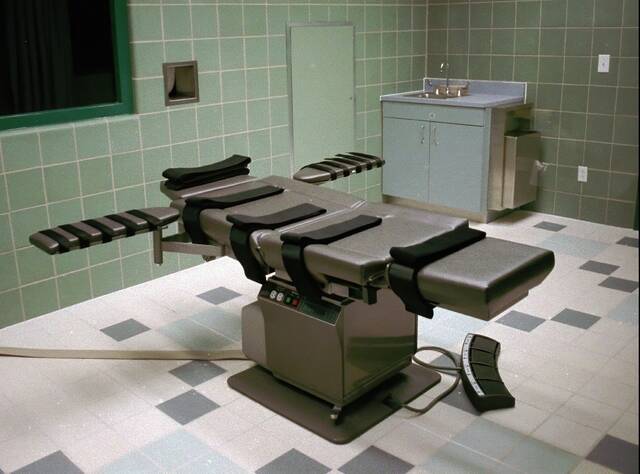Last week, catastrophe struck Frick Park as the Fern Hollow Bridge collapsed and tumbled to the ravine floor. Fortunately, no one was killed or seriously injured, but the collapse took several vehicles with it, including a Port Authority bus.
The collapse made national headlines, and even garnered attention from President Joe Biden. While the scale of the collapse was massive, and the Fern Hollow Bridge isn’t likely to reopen for at least two years, it was just one of at least a dozen large-scale infrastructure failures to occur across Southwestern Pennsylvania.
Fern Hollow Bridge collapse
The most recent infrastructure failure is the aforementioned Fern Hollow Bridge collapse. The bridge carrying Forbes Avenue over Frick Park fell in the early morning of Jan. 28. It is unclear why the bridge collapsed, and an investigation is ongoing.
The bridge was rated in poor condition, according to PennDOT, and in 2018, a rusted brace on the bridge was removed and replaced with steel cables. The bridge also was given a 26-ton per vehicle weight limit in 2014. When it fell, a 22-ton bus was on the bridge, as were a handful of other private vehicles.
Route 30 collapse
A 300-foot section of Route 30 in East Pittsburgh dropped about 40 feet down a steep hill on April 7, 2018. One apartment building collapsed as a result, and another was so badly damaged it had to be demolished.
The section of Route 30, which carries between 25,000 and 30,000 vehicles per day, was closed for three months while PennDOT crews built a new retaining wall 20 feet high and 400 feet long to replace the one that collapsed.
The cost was estimated at $5 million to $7 million.
Sinkhole Bus
In 2019, a giant sinkhole opened on 10th Street in Downtown Pittsburgh and swallowed the back end of a Port Authority bus. The sinkhole caused the front of the bus to be thrusted into the air, creating an image that went viral. Flowing water likely deteriorated the ground underneath the street and caused the sinkhole to form.
Southwestern Pennsylvania has a karst landscape which is prone to sinkholes because underground water breaks down the bedrock. It’s unclear where the source of the underground water came from. A passenger on the bus during the sinkhole event has alleged that Pittsburgh Water and Sewer Authority is to blame.
Floating Dumpster
Flooding along Route 51 in the South Hills is a regular occurrence during heavy rainstorms, and nothing symbolizes that more than the floating dumpster that scurried across the watery roadway in May 2018.
Dumpster on the move on flooded Route 51 in Pittsburgh @kdka pic.twitter.com/BYeVpUhvcl
— Ken Rice (@kenricekdka) May 17, 2018
Route 51 regularly can’t handle heavy rains, and has flooded scores of times over the decades. Only minor fixes to the road over the decade have addressed the issue, but in 2020, flooding mitigation was undertaken in Overbrook to help catch stormwater.
Viral memes cropped up on social media of an ablaze floating dumpster, though the Route 51 dumpster never actually caught fire.
Pipeline Explosion in Beaver County
In September 2018, a natural-gas pipeline owned by Energy Transfer in Beaver County exploded, damaging one home and shooting fire 150 feet into the air. Twenty-five homes were evacuated for about half a day. The explosion was caused by a landslide, which an investigation found was triggered by the company’s failure to install adequate erosion control equipment at the hillside site. The Revolution Pipeline was completed just a few weeks before the explosion. Energy Transfer is currently facing charges from the state attorney general.
Train Derailment at Station Square
A Norfolk Southern train carrying 46 double-stacked containers on 23 rail cars derailed and fell onto the Station Square T station in September 2018, damaging the Port Authority’s rails enough that it took weeks before it could run light-rail cars through the station.
Norfolk Southern determined a broken rail caused the derailment. An investigation by the Federal Railroad Administration found that there was a defect in the rail, which caused the derailment, and that an inspection three weeks before the incident failed to catch the defect.
Liberty Bridge fire
In September 2016, one of the most trafficked bridges in Pittsburgh caught fire. The Liberty Bridge had to be shut down for 24 days. Tarping and plastic pipes were ignited on accident by a welder, which then burned and damaged a sensitive part of the bridge. The fire led to $3 million in damages, according to PennDOT.
Landslides over McArdle Road in Pittsburgh
PJ McArdle Roadway carries drivers up to Mt. Washington, but has also regularly been hit with landslides that close the street down. In 2014, a landslide closed the road down for three hours. In December 2012, the road was closed for a few weeks because of a landslide. The worst came when a large landslide hit McArdle in January 2012, which closed the road for about three months, and cost the city of Pittsburgh $700,000 to clear.
Birmingham Bridge Slip
An infrastructure failure that could have been much worse. In February 2008, a portion of the bridge dropped eight inches and was immediately closed by officials.
It was discovered that the rocker bearings on the bridge were likely improperly installed and a leaking expansion joint contributed to and accelerated the corrosion of the bearings, according to a forensic report from PennDOT. This likely caused a lean in the bridge. The Birmingham Bridge was reopened to single lane traffic in March 2008, and eventually the rocker bearing system was replaced.
Train Derailed over Beaver River
In October 2006, a Northfolk Southern train derailed while crossing the Beaver River in New Brighton. It was carrying 83 tank cars loaded with denatured ethanol, which is flammable. The derailment caused 23 of those tank cars to fall, with several plunging into the Beaver River. About 20 of the cars released ethanol, which then ignited and burned for about two days. Homes in a several block radius were evacuated for two days. The National Transportation Safety Board determined that the derailment was caused by Norfolk Southern’s inadequate rail inspection and maintenance program.
Landslide closes Route 65 in Kilbuck
A massive landslide hit Kilbuck Township in September 2006, dumping 500,000 cubic yards of dirt and rocks and shutting down Route 65. It was one of the largest landslides in state history, and it took more than seven years to stabilize. The site of the landslide was originally slated to become a Walmart, and the large company sued its contractors in an attempt to recoup costs.
Walmart tried to claim that one of its contractors caused the landslide with a blast the contractors set off the day before the landslide, but an Allegheny County judge sided with the contractors and ruled they could only be held liable for doing something outside of its contract without Walmart’s knowledge.
Partial Bridge Collapse over 1-70
The Fern Hollow Bridge wasn’t the only bridge to fail in recent Southwestern Pennsylvania history. In December 2005, a concrete bridge beam collapsed onto Interstate 70 in Washington County, closing a 3.5 mile stretch of the interstate in both directions. A 50-foot, 125-ton section of concrete of the Lakeview Drive Bridge fell onto the interstate. A woman and her daughter suffered minor injuries after their minivan slide, caused by the collapse. The cause of the partial collapse was wear and tear from 45 years of corrosive road salt draining onto the section of the bridge and a history of trucks hitting its underside.


